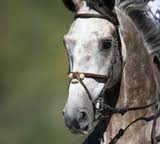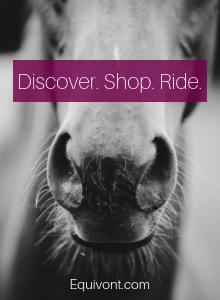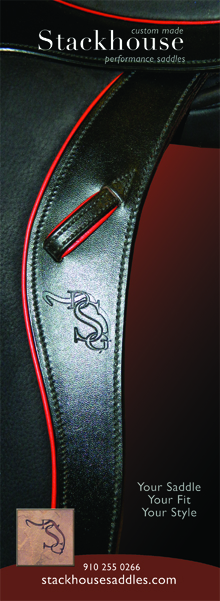Search the Site
How Horses Learn From Mistakes (Current Freebie!)

Have you ever wondered why horses sometimes seem to make the same mistake over and over? Why they seem to not be learning from the mistake they made? For example, say your horse rushes into a jump, ignoring your desperate attempts to slow him down, gets in too close, and hits the rail hard, knocking it down. And instead of learning from the last attempt where he whacked his shins on the rail, and listening to your attempt to slow him down the next time - he gets even more frantic, and runs even faster up to the fence, hitting it again! Why is he not learning that he will hit the fence if he runs up underneath it?
The answer is because he blames the rail down on you. Because you used the reins to try to slow him down, what he learned was that you were going to fight with him in front of the jump. And that caused anxiety that makes it hard for him to learn. In order for the horse to learn to look after himself, and not run in underneath the jumps, he needs to be free to focus on himself and the jump in front of him. He can not be preoccupied with anything the rider is doing. If he is truly free to focus on the exercise in front of him, then he only has himself to blame when something goes wrong.
For this reason, if you really want your horse to learn to be more careful, and to learn that rushing into the jumps and running past the distance causes him trouble, the best thing to do is to set up an exercise, where the exercise can teach him with little to no imput from you. With a horse like this, gridwork is a great place to start.
Set up a cross rail with a placing pole in front of it, 18 feet to a vertical, and 19 feet to a square oxer. Come into the cross rail in a quiet trot, and just in front of the placing pole loosen the reins. Let your horse go through the gymnastic on loose reins, even and especially if he wants to go too fast. Make sure you stay quiet with your body, so as not to accidentaly encourage him to rush. Resist the urge to do anything to slow him when he rushes, other than a calm verbal "whoa". And if he rushes, and "eats the rail", just quietly pull up afterwards, and come again. Stay calm and ride the same way, and I bet it won't take a time or two before he starts to steady himself so that he can jump cleanly. If after a few tries, he isn't learning to back up and wait, you can add a pole on the ground exactly between each element of the gymnastic. Then come through again, and let the poles do their job. With loose reins and a calm and still rider aboard, he will begin to understand how to wait instead of running underneath the jumps. And honestly, if I come across a horse that doesn't learn to take care of himself on loose reins in a grid and jump cleanly - that is not a horse that I want to ride cross country!
So, now how do we apply this to single jumps and courses? Once this type of horse has learned the lesson that he needs to learn in the gymnastic lines, I expect him to eventually apply it to single jumps. But usually I bridge the gap by starting off with single jumps that have placing poles on either side. This way I can again let the poles on the ground do the job of regulating his stride, as well as his takeoff and landing. I would do lots of flatwork, working on the adjustability exercise, until I felt the horse was listening to me. No sense aiming at a jump if the horse is running through my aids on the flat. Once he is listening to me, I would aim at a single jump with a placing pole, and soften the reins in front of the placing pole, even if he goes too fast. Just like in the gymnastic line, I would be careful to be calm and quiet with my position, and give a verbal "whoa", but I wouldn't touch the reins. Then if he rushes, and hits the jump - it will be on him, not me.
The next step would be to do courses with lots of flatwork between jumps to ensure that the horse is listening, and placing poles on every jump so that I could soften the rein in the last stride rather than trying to hold him off of it. And once that is going fairly well, I would begin to keep the rein consistent in the last strides rather than loosening the reins. By this point, the horse should have learned to focus on the jump, and how to not get himself in trouble by running in underneath the jump. If he begins to deteriorate when I keep a feel in the last few strides, then I go back a step again for a while. And I also keep in mind that maybe this is the kind of horse that will always need a rider to soften the reins in the last strides of the approach. Not to the point of being loose necessarily, but soft.
The above is just one example, but applies to any task that the horse needs to focus on - like trotting poles or negotiating uneven terrain. If you interfere with the horse as he trips over the trotting poles, or a rut or a log on the ground on the trail, he will associate the trouble with your interference. If you give him his head, and he steps on the poles or trips over a log on the ground, he will be more aware of his mistake, and will usually be more careful from then on.
Remember that in general horses learn best when they find that they have the power to reward and punish themselves. If you are asking for bend to the inside on the flat - when your horse complies and the aids instantaneously stop, he learns that he did the right thing. If he complies and the aids persist, he will be frustrated, as he won't know what is right. The burden is on the rider to be quick to give feedback, so that he learns right and wrong. And while praise and reward are important, a horse's favorite form of feedback is the lessening or ceasing of the aids when he has the right answer. Horses long for the ability to do their jobs with minimal aiding from the rider. Lots of aids, whether hand or leg, become similar to a white noise to the horse - dulling him to that aid.
It should feel to the horse like rooting on the reins or bucking causes a pain in his sides, because the rider is so accurate with the timing of their correction (kicking their sides) when the horse does either. Kick or hit the horse after a buck and you will likely get another buck. But if you can time the punishment while the action is still taking place, the horse can learn to associate that behavior with the punishment.
People are really the same way, they learn from their mistakes the best when there is nothing to distract them from the very obvious cause and effect of their actions. So set your horse up properly, and then let him alone to do his job with as little distracting extraneous "noise" from your aids as possible. This gives him the best chance to learn from his mistakes, as he can't pin any mistakes made on something that you did.






